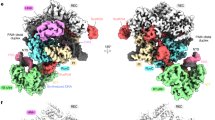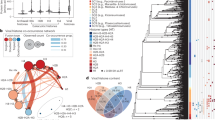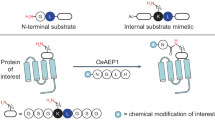Abstract
Approximately 25% of cytoplasmic tRNAs in eukaryotic organisms have the wobble uridine (U34) modified at C5 through a process that, according to genetic studies, is carried out by the eukaryotic Elongator complex. Here we show that a single archaeal protein, the homolog of the third subunit of the eukaryotic Elongator complex (Elp3), is able to catalyze the same reaction. The mechanism of action by Elp3 described here represents unprecedented chemistry performed on acetyl-CoA.
This is a preview of subscription content, access via your institution
Access options
Subscribe to this journal
Receive 12 print issues and online access
$259.00 per year
only $21.58 per issue
Buy this article
- Purchase on Springer Link
- Instant access to full article PDF
Prices may be subject to local taxes which are calculated during checkout



Similar content being viewed by others
References
Otero, G. et al. Mol. Cell 3, 109–118 (1999).
Krogan, N.J. & Greenblatt, J.F. Mol. Cell. Biol. 21, 8203–8212 (2001).
Winkler, G.S. et al. J. Biol. Chem. 276, 32743–32749 (2001).
Chinenov, Y. Trends Biochem. Sci. 27, 115–117 (2002).
Sofia, H.J., Chen, G., Hetzler, B.G., Reyes-Spindola, J.F. & Miller, N.E. Nucleic Acids Res. 29, 1097–1106 (2001).
Wittschieben, B.O. et al. Mol. Cell 4, 123–128 (1999).
Huang, B., Johansson, M.J. & Bystrom, A.S. RNA 11, 424–436 (2005).
Mehlgarten, C. et al. Mol. Microbiol. 76, 1082–1094 (2010).
Chen, C., Tuck, S. & Bystrom, A.S. PLoS Genet. 5, e1000561 (2009).
Singh, N., Lorbeck, M.T., Zervos, A., Zimmerman, J. & Elefant, F. J. Neurochem. 115, 493–504 (2010).
Bauer, F. et al. Cell Reports 1, 424–433 (2012).
Moukadiri, I. et al. Nucleic Acids Res. 37, 7177–7193 (2009).
McCloskey, J.A. et al. Nucleic Acids Res. 29, 4699–4706 (2001).
Chen, C., Huang, B., Eliasson, M., Ryden, P. & Bystrom, A.S. PLoS Genet. 7, e1002258 (2011).
Grove, T.L. et al. Science 332, 604–607 (2011).
Kim, J. et al. Nature 498, 123–126 (2013).
Pokholok, D.K., Hannett, N.M. & Young, R.A. Mol. Cell 9, 799–809 (2002).
Fichtner, L., Frohloff, F., Jablonowski, D., Stark, M.J. & Schaffrath, R. Mol. Microbiol. 45, 817–826 (2002).
Holmberg, C. et al. J. Biol. Chem. 277, 31918–31928 (2002).
Kim, J.H., Lane, W.S. & Reinberg, D. Proc. Natl. Acad. Sci. USA 99, 1241–1246 (2002).
Ragab, A.E., Gruschow, S., Tromans, D.R. & Goss, R.J. J. Am. Chem. Soc. 133, 15288–15291 (2011).
Broussard, T.C., Price, A.E., Laborde, S.M. & Waldrop, G.L. Biochemistry 52, 3346–3357 (2013).
Fu, Y. et al. Angew. Chem. Int. Edn Engl. 49, 8885–8888 (2010).
Acknowledgements
The study was supported by US National Institute of Health (GM107533 to R.H.H.). We thank Y. Fu and C. He (University of Chicago) for providing us with the synthetic cm5U, F. Sun for assistance with ESI-LC/MS, J. Li and E. Oldfield for assistance with EPR and J. Imlay for the initial use of an anaerobic chamber.
Author information
Authors and Affiliations
Contributions
R.H.H. conceived the project. K.S. and R.H.H. designed the experiments. K.S. expressed and purified proteins, in vitro transcribed and purified tRNA substrate and performed in vitro reconstitution. K.S. and R.H.H. performed RP-HPLC and ESI-LC/MS analyses. P.W. and J.S. assisted K.S. in the purification of Elp3 and tRNA. R.H.H. wrote the manuscript with input from other authors.
Corresponding author
Ethics declarations
Competing interests
The authors declare no competing financial interests.
Supplementary information
Supplementary Text and Figures
Supplementary Results and Supplementary Figures 1–9. (PDF 2528 kb)
Rights and permissions
About this article
Cite this article
Selvadurai, K., Wang, P., Seimetz, J. et al. Archaeal Elp3 catalyzes tRNA wobble uridine modification at C5 via a radical mechanism. Nat Chem Biol 10, 810–812 (2014). https://doi.org/10.1038/nchembio.1610
Received:
Accepted:
Published:
Issue Date:
DOI: https://doi.org/10.1038/nchembio.1610
This article is cited by
-
A novel splice variant of Elp3/Kat9 regulates mitochondrial tRNA modification and function
Scientific Reports (2022)
-
Iron–sulfur clusters as inhibitors and catalysts of viral replication
Nature Chemistry (2022)
-
Genome-wide CRISPR screen identifies ELP5 as a determinant of gemcitabine sensitivity in gallbladder cancer
Nature Communications (2019)
-
Identification of a radical SAM enzyme involved in the synthesis of archaeosine
Nature Chemical Biology (2019)
-
The many lives of KATs — detectors, integrators and modulators of the cellular environment
Nature Reviews Genetics (2019)



